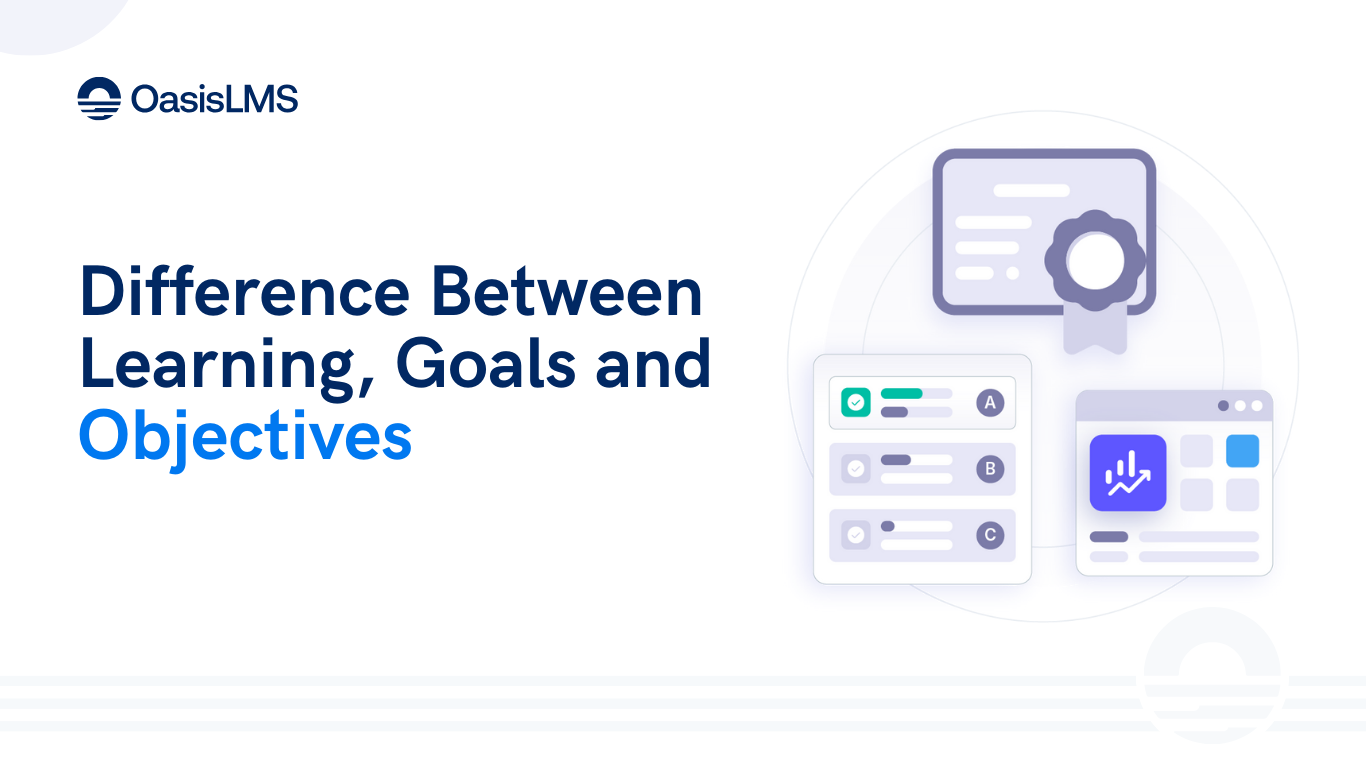
When creating Continuing Medical Education (CME) programs, understanding your instructional framework is important. Terms like learning goals, learning objectives, learning outcomes, and competencies get used incorrectly and interchangeably even though they have distinct meanings and play unique roles in the instructional design process.
We will break down the difference between learning goals and objectives, offer real-world learning objective examples for CME, and explore how these concepts align with building courses for adults (versus younger students). We’ll also define learning outcomes in the context of CME and show how they fit into a broader educational strategy.
Learning goals are general, idealistic statements of what the end goal of a learning program should be. They are the base of which more specific learning components are built and help to communicate the intent of the course to learners, faculty, and accrediting bodies.
• General and not directly measurable
• Focused on the overall purpose of the learning experience
• Useful for aligning content, outcomes, and objectives
Example:
“Improve physicians’ ability to diagnose and manage autoimmune disorders.”
This is not something you would measure directly, but it gives direction to course developers, instructors, and learners alike as they create the content for the course.
Unlike goals, objectives are specific items that can be measured with outcomes. They represent the concrete steps learners need to take in order to move toward the overarching goal.
In the context of CME, learning objectives must align with:
· Needs assessments
· Accrediting body guidelines (e.g., ACCME or ANCC)
· Bloom’s Taxonomy or other frameworks for cognitive skill progression
See some samples for a diabetes management course :
· Define the criteria for diagnosing Type 2 diabetes according to ADA guidelines.
· Compare first-line treatment options for newly diagnosed adult patients.
· Demonstrate how to modify treatment plans for patients with cardiovascular comorbidities.
· Analyze patient case studies to identify contraindications for common diabetes medications.
Each of these is:
· Action-oriented (define, compare, demonstrate, analyze)
· Measurable via assessments or clinical evaluations
· Clinically relevant to healthcare professionals in practice
When creating content for CME, it's critical to apply best practices from instructional design for adult learners. Adults learn differently from younger students. They bring prior experience, need immediate relevance, and are motivated by real-world application.
1. Self-direction – Allow learners to control their pace or sequence.
2. Experience-based – Incorporate prior knowledge into new learning.
3. Goal-oriented – Clearly communicate learning outcomes and how they apply to practice.
4. Problem-centered – Present real-world clinical challenges.
5. Relevance – Show direct application to current roles or responsibilities.
By designing with these principles in mind, you create an educational experience that engages physicians and healthcare professionals at a deeper level, increasing the likelihood of meaningful performance change and ultimately practice improvement.
A learning outcome is a statement that defines what a learner will be able to show or demonstrate once the course is finished. It goes beyond what is taught and instead focuses on what is actually achieved by the learner.
Learning Outcome Definition in CME:
A measurable result that reflects a change in knowledge, competence, performance, or patient outcomes resulting from a CME activity.
Example Outcome:
Participants will apply the 2023 hypertension treatment guidelines in 70% of patient encounters where elevated blood pressure is identified.
This type of outcome is often assessed through post-activity evaluations, performance improvement metrics, or follow-up surveys 30–90 days after participation.
Let’s look at how these components work together in a well-designed CME course:
1. Learning Goal:
Improve cardiovascular risk management among primary care providers.
2. Learning Objectives:
· Identify key risk factors for cardiovascular disease.
· Interpret diagnostic lab results related to lipid profiles.
· Describe updated treatment protocols based on current guidelines.
3. Learning Outcomes:
· 85% of learners correctly identify patient risk profiles in post test scenarios.
· 60% report modifying their prescribing habits within 3 months.
In the CME world, accrediting bodies like ACCME (Accreditation Council for Continuing Medical Education) and ANCC (American Nurses Credentialing Center) require a specific approach to course building and measuring outcomes.
Best Practices:
· Try to relate each objective to a previously identified gap in knowledge, or performance.
· Use Moore’s Outcomes Framework to define and categorize your outcomes (Levels 1–7).
· Collect data that supports changes in competence, performance, or patient outcomes, not just satisfaction, like a performance improvement evaluation.
How These Terms Work Together
Knowing the difference between learning goals and objectives isn’t just for fun, it will help your organization create more meaningful learning experiences. Combine that knowledge with an understanding of the learning outcome definition in CME and a commitment to instructional design for adult learners, and you're now ready to design powerful, results based education.
Whether you're building enduring materials, live webinars, or PI-CME programs, the key is alignment: every piece should support the ultimate goal of improving clinical care.
Need help planning, tracking, and reporting these educational elements seamlessly? Oasis LMS is built for CME providers, with tools to align goals, track objective completion, and measure outcomes at scale.
Whether managing CME for physicians or supporting member growth, Oasis LMS helps deliver high-impact education efficiently and at scale.
